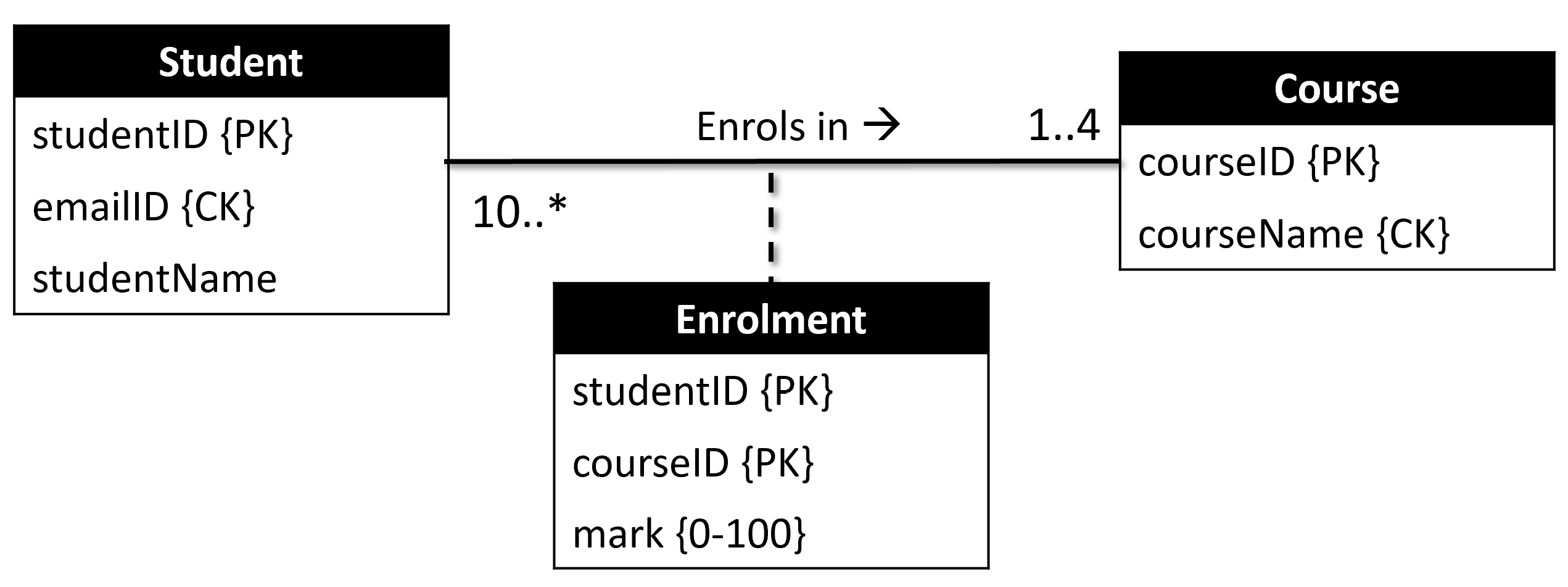
Table of Contents Link to heading
Definition Link to heading
Constraints are clauses that need to be satisfied by data in the database.
Constraints are like contracts to guard against bad data.
Data that does not meet the rules of a given constraint will not be saved to the database.
- The whole tuple (new record) gets rejected and the DBMS throws an SQL Error.
- For example:
- PRIMARY KEY Violation
- FOREIGN KEY Violation
- CHECK CONSTRAINT Violation
Hypotheses Link to heading
Consider this example:
Students(studentID, studentName, gpa)
Enrolment(studentID, courseID, mark)
If there is no constraint:
- What if we insert a tuple into Enrolment, but there is no corresponding student?
- What is we delete a student?
Syntax Link to heading
CREATE TABLE Enrolment (
student int,
course int,
mark decimal(3, 2),
CONSTRAINT PK_Enrolment PRIMARY KEY (course, student),
CONSTRAINT FK_Enrolment_Student FOREIGN KEY (student) REFERENCES Student (studentID),
CONSTRAINT FK_Enrolment_Student FOREIGN KEY (course) REFERENCES Course (courseID),
CONSTRAINT checkMark CHECK (mark >= 0 AND mark <= 100)
);
Categorisation Link to heading
There are two major constraint types:
Intra-Relational Constraints Link to heading
Those that affect attributes within a table.
Attribute constraints – checked each time the attribute’s value is modified.
- Domain
- The data type (varchar(n), int, decimal(m, n), etc.)
- Ensures data is of the correct type.
- PRIMARY KEY
PRIMARY KEY (studentID)- Ensures a record does not get entered more than twice.
- UNIQUE KEY
UNIQUE (emailID)- Forces each emailID to be unique (a Candidate/alternate Primary Key).
- NOT NULL
studentName NOT NULL- Forces a value to be entered.
- CHECK
CHECK (mark >=0 AND mark <= 100)- Ensures a value is in a given range (dates, decimals, etc.)
- IDENTITY
- Not a constraint, but a property.
PRIMARY KEY (studentID) IDENTITY- Makes the studentID an auto-incrementing number (thus always unique).
- Only works for the int data type.
- An OK Approach
CREATE TABLE ColumnLevelConstraints (
id int PRIMARY KEY,
startDate date NOT NULL,
endDate date NOT NULL,
dateChecked date CHECK (dateChecked > '01/Aug/2015') NOT NULL
);
- A recommended Approach
CREATE TABLE ColumnLevelConstraints (
id int,
startDate date NOT NULL,
endDate date NOT NULL,
dateChecked date NOT NULL,
CONSTRAINT PK_TableName PRIMARY KEY (id),
CONSTRAINT dateCheck CHECK (dateChecked > '01/Aug/2015')
);
Inter-Relational Constraints Link to heading
Those that affect attributes and values across tables.
Foreign Key (referential) constraints:
- Is a contract between tables to ensure a related record exists (e.g. no orphan records).
- Syntax:
- For single or multiple attribute FK(s).
FOREIGN KEY (Attribute {, Attribute}) REFERENCES TableName (Attribute {, Attribute})
- For example:
- FOREIGN KEY (student) REFERENCES Student(studentID)
A good approach:
CREATE TABLE Enrolment (
student int,
course int,
mark int,
CONSTRAINT PK_Enrolment PRIMARY KEY (student, course),
CONSTRAINT FK_Enrolment_Student FOREIGN KEY (student) REFERENCES Student (studentID),
CONSTRAINT FK_Enrolment_Course FOREIGN KEY (course) REFERENCES Course (courseID)
);
FK constraints can have reaction policies in response to violations of referential integrity.
- These operate on the secondary/child table, after changes made to the primary/parent table.
- Violations may be introduced by updates on the referenced attribute or by row deletions.
Consider the Enrolment table referencing the Student table when a student is deleted.

ON UPDATE | DELETE NO ACTION- no action is performed with the child data when the parent data is deleted or updated.- Do not permit the change – default behaviour.
ON UPDATE | DELETE CASCADE- the child data is either deleted or updated when the parent data is deleted or updated.- Are you going to lose anything important?
ON UPDATE | DELETE SET NULL- the child data is set to NULL when the parent data is deleted or updated.- Does the FK column allow NULL values? (is it part of a PK/NOT NULL?) – orphan records.
ON UPDATE | DELETE SET DEFAULT- the child data is set to their default values when the parent data is deleted or updated.
CREATE TABLE Enrolment (
student char(5) REFERENCES Student (studentID)
ON UPDATE CASCADE
ON DELETE CASCADE,
course char(5) REFERENCES Course (courseID)
ON UPDATE CASCADE
ON DELETE CASCADE,
mark int,
CONSTRAINT PK_Enrolment PRIMARY KEY (student, course)
CONSTRAINT validMark CHECK (mark >= 0 AND mark <= 100),
);
Same Enrolment table but with constraint names.
- Naming a constraint allows you to drop it from the table when needed.
- Otherwise, the whole table has to be dropped and re-created: data lost.
- It can also help with debugging a query when reading error messages.
CREATE TABLE Enrolment (
student int,
course int,
mark int,
CONSTRAINT PK_Enrolment PRIMARY KEY (student,course),
CONSTRAINT validMark CHECK (mark >= 0 AND mark <= 100),
CONSTRAINT FK_Enrolment_Student FOREIGN KEY (student) REFERENCES Student (studentID)
ON UPDATE CASCADE
ON DELETE CASCADE,
CONSTRAINT FK_Enrolment_Course FOREIGN KEY (course) REFERENCES Course (courseID)
ON UPDATE CASCADE
ON DELETE CASCADE
);